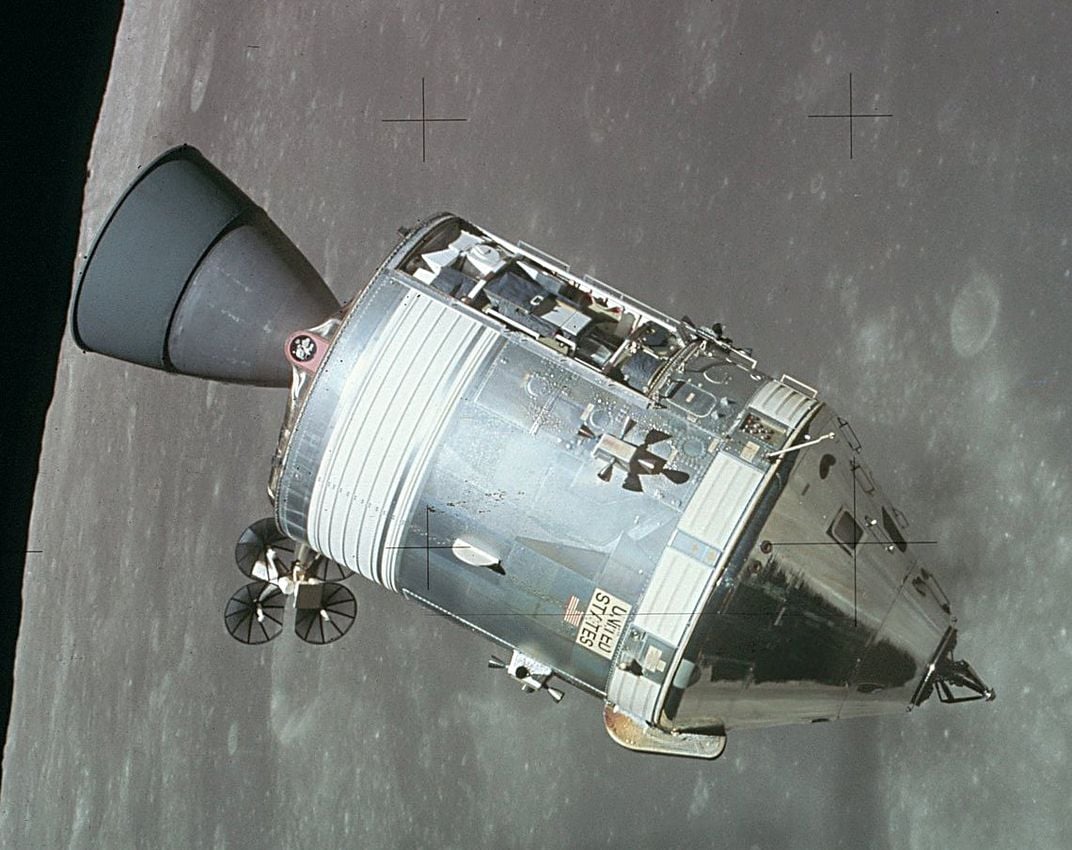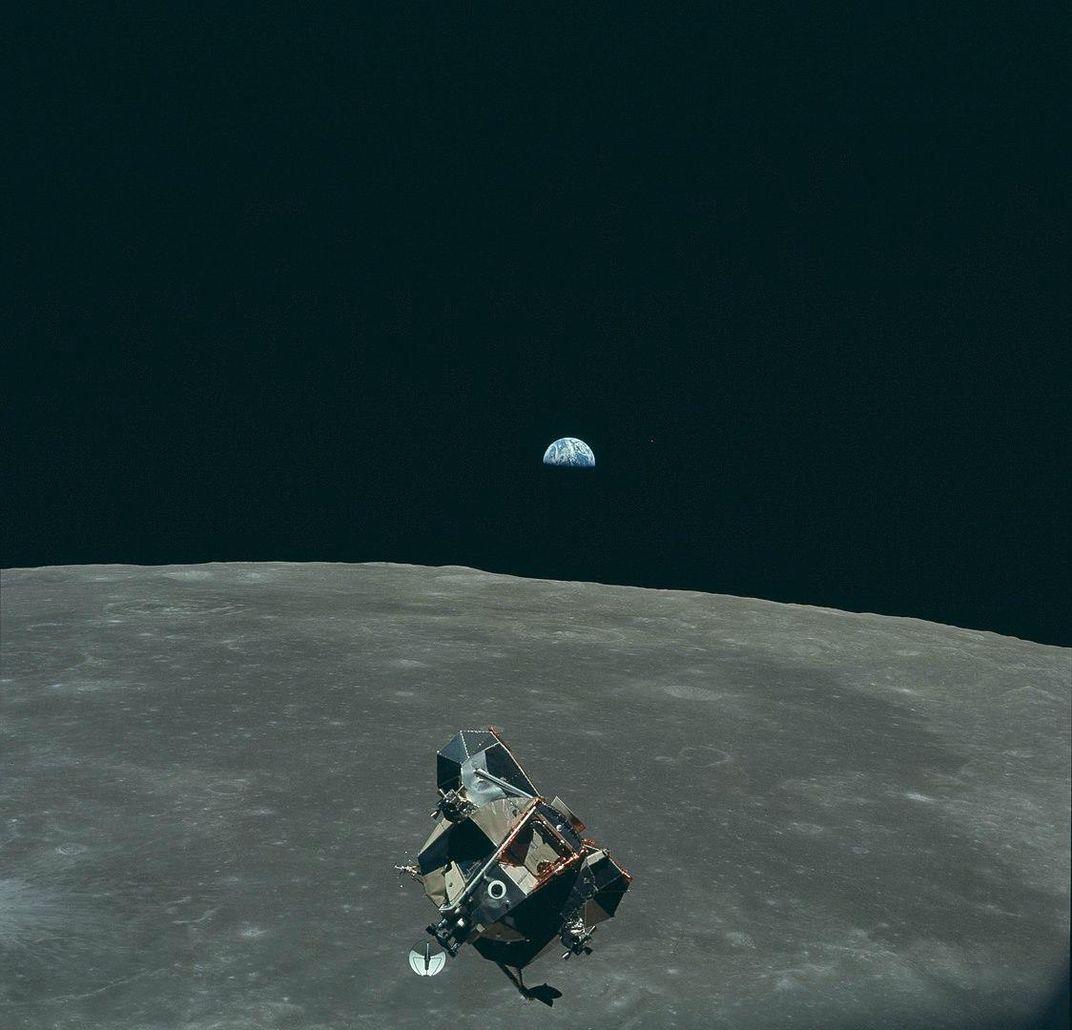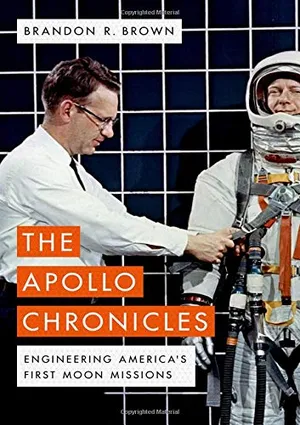Apollo Engineers Discuss What It Took to Land on the Moon
The people who bent metal and built spaceships recall the culture and leadership that made it possible to send humans to the lunar surface
/https://tf-cmsv2-smithsonianmag-media.s3.amazonaws.com/filer/b1/f5/b1f5b07d-943a-48a4-8186-b10dbb7895a0/ap10-ksc-69pc-110.jpg)
After the 1972 conclusion of the Apollo program, a group of about 30 NASA thoughtleaders sequestered themselves for a few days on Caltech’s sunny campus. They reviewed what they had accomplished and tried to grapple with exactly how they had pulled off the challenge of the century: landing humans on the lunar surface and returning them safely to Earth on an absurd deadline.
Neil Armstrong, the first man to set foot on the moon, attended most of their sessions in relative silence. While known to be quiet, he was never what someone would call shrinking or invisible. His thoughtful presence carried significant weight in any meeting. Armstrong was not a typical test pilot turned astronaut. “I am, and ever will be,” he once said, “a white-socks, pocket-protector, nerdy engineer.”
After everyone else had finished speaking at the Caltech gathering, Armstrong calmly rose and went to a chalkboard. He drew four bell-type curves, spaced slightly apart, and labeled them: Leadership, Threat, Economy and Talent. And he said to the room, “My thought is, when you get all these lined up, you can’t stop something really big from happening.” Indeed, the early 1960s had it all: a bold (and in some ways, desperate) president; the threat of the Soviet Union; flush federal coffers; and an unprecedented number of college-educated youngsters. When the curves aligned, Armstrong suggested that an Apollo could rise. According to Gerry Griffin, engineer, flight director and eventual director of the Johnson Space Center, everyone in the room was nodding in agreement, as if to say “Of course, that’s it.”
The Apollo Chronicles: Engineering America's First Moon Missions
The moon landing of 1969 stands as an iconic moment for both the United States and humankind. The familiar story focuses on the journey of the brave astronauts, who brought home Moon rocks and startling photographs. But Apollo's full account includes the earthbound engineers, mounds of their crumpled paper, and smoldering metal shards of exploded engines.
The analysis of rarely aligned curves can help explain why we haven’t yet sent humans back into the cosmos. But four peaks fail to fully capture the miracle: 400,000 souls uniting in peacetime on a project so ambitious as to appear ludicrous. As humanity makes ample noise about restarting these journeys to other worlds, it’s worth looking under Apollo’s hood and asking the surviving engineers how they did it. Based on scores of recent interviews, their most frequent and fervent responses follow.
Precise Target
Apollo had a goal of perfect clarity. As advised by NASA leadership, President Kennedy and Vice President Johnson stated the mission criteria in a way that every engineer, every politician and really everyone on the planet could understand. In 1961, Wernher von Braun said Kennedy’s announcement “puts the program into focus. … Everyone knows what the moon is, what this decade is, what it means to get some people there.” The only remaining gray areas resided on the moon itself. Ironically, the clarity of Apollo made the next steps difficult at best. How could NASA get that many people on the same page again?
Agency in the Agency
Nearly every Apollo-era engineer will tell you they owned their work. Approaching the first landing in July of 1969, each of them sat hyperventilating. Whether it might be miscalculating the fuel supply, overlooking a tiny flaw in an engine, mistyping the computer code, or mistaking the moon’s spastic gravity, the engineers lived, breathed and sweated their contributions.
/https://tf-cmsv2-smithsonianmag-media.s3.amazonaws.com/filer/a6/19/a6192542-2293-4300-b0b9-0b3cbe71f904/s-ic-d_positioning_for_shake_test.jpg)
The responsibility bestowed and respect given to each employee was woven into the organization’s DNA before it was NASA. The twin cultures of a Langley, Virginia, research laboratory, driven by engineer Robert Gilruth, and the Huntsville, Alabama, rocketry team, led by Wernher von Braun, both worked with loose leashes and high expectations.
A number of engineers recalled the positive culture at Langley, the very headwaters of America’s space program. “It was the greatest place to work in the world,” engineer Guy Thibodaux said. “All the ideas started at the bottom and came up to the top, and the managers had enough sense to kind of steer you or guide you, but never interfere with your work.” The engineers routinely mention trust. If your part, or your system, or your simulation was supposed to work, everyone around you assumed it would work by the required deadline. It had to be perfect, because for many years the project featured few extra levels of double-checking.
“Nobody at NASA was micro-managed by their boss,” says Gerry Griffin. “From the beginning... the lowest rank could speak up. The leadership wanted everyone to be heard. They let us do our thing... empowered us and held us accountable.” He cites the wounded Apollo 13 mission, where as flight director, he told NASA’s leaders that he planned to send a badly wounded spacecraft behind the moon to boomerang its way home instead of turning the ship around directly. Griffin says the brass listened and then asked “What do you need? What can we do to help you succeed?”
A striking example of responsibility overcoming rank sits tucked away in a mundane yet tricky task: How would NASA scoop a returning conical capsule from the ocean, without the capsule turning over and sinking, without it pulling a helicopter into the ocean, and without it banging against the side of a naval recovery ship and injuring its precious human cargo? Engineer Peter Armitage recalled testing an early capsule for seaworthiness. As the engineer in charge, he stood with his boss and noted the capsule listing—they had to intervene quickly, or the whole expensive craft would be lost. “Do you want me to swim a line out?” his boss asked. Armitage laughed at the memory of this. “I said, ‘Sure.’ I mean, he’s asking me, because I’m the test engineer and he recognizes who he’s put in charge.” His boss stripped down to his underwear, swam to the capsule and attached a rope.
Responsibility often arrived with little warning. A fresh-faced employee could walk into a big meeting, hoping to just listen and learn instead of speaking. But when a thorny, unsolved problem arose a boss invariably stood up and pointed to the blushing youngster. By the end of the meeting, she or he might own a new project—a project that had neither name nor acronym just an hour earlier.
Dirty Hands
From his first days in Huntsville, von Braun told his colleagues he wanted his group leaders to “keep their knowledge up to date and judgment sharp by keeping their hands dirty at the work bench.” And when Robert Gilruth was planning the new Manned Spaceflight Center south of Houston, he told his inner circle they had to build more than office buildings. “I do not want to have our people, our engineers, sit in their offices and only look at paper,” he said. “I want them to get their hands dirty, understand the hardware, bring it here and test it.” Both Gilruth and von Braun wanted all of their managers to maintain technical chops.
When thinking back on the space program, engineer Henry Pohl starts with the leaders. “Every one of those people grew up in a laboratory doing things themselves,” he says. “So when it came time to manage people all over the United States and contractors of every persuasion, they could do it from the standpoint of having been there, of knowing what it took to do the job.”

A number of engineers tell stories of underestimating von Braun’s own engineering skills. After his many magazine and television appearances, some assumed he was just a silver-tongued space salesman. “I always thought of von Braun as being a figurehead,” engineer Marlowe Cassetti says. But one day late in the Apollo program, Cassetti had to brief key leadership on the lunar lander’s weight gain problem. Von Braun peppered him with penetrating equipment questions. They delved into the ounces of obscure parts in the lander’s engine. “I shouldn’t have been surprised by how he knew the technical details.”
Engineer Aldo Bordano started at the Houston center straight out of college. “Our bosses were really something we wanted to emulate,” he says. “I wanted to be able to ask intelligent questions.” He pauses a bit. Thinking back over his entire career, he says it was successful exactly because he spent the entire time trying to embody those talented NASA elders.
The Teamwork
This might go without saying, but the retired engineers mention goodwill and sacrifice in NASA’s early years. “It was just instilled in people,” Cassetti recalls. “You would see people who would try to build empires.” As in most organizations, some connived to thwart office rivals and accumulate resources. But at NASA “they would be just absolutely steamrolled by this team. I saw it time and time again.” One didn’t have to be nice—people were routinely brutal and competitive with one another on technical issues. But the culture assumed and demanded a selflessness. Many of the engineers have stories about a person hoarding information or prioritizing his next promotion but finding himself pushed effortlessly aside or even out of the agency. The group spirit, like a rushing flood, swept selfish clutter and impediment aside. “You know, I never did worry about who got credit for anything,” Pohl says. “As long as the right thing was done.” He cites the “common cause” of beating the Russians as the primary uniting power at work. Some still yearn for those early days, when, as one says, “Everybody needed everybody.”
The organization’s youth played a leading part here as well. Waves of people in their twenties could not only sink long hours into an engineering adventure, but they were also less likely to demand recognition for their ideas, seethe over blunt criticism, or wonder about the next pay raise. Many recall their NASA job offer as the most meager of several salary options. But they wanted to join the space race. If nothing else, most of the engineers will credit their youth for giving them the requisite energy and fearlessness for confronting hurdles that looked insurmountable.
The field of neuroscience has made its own giant leaps since Apollo. The brain, we now know, busily sculpts its garden of neural connections well into our 20s. Our thinking is literally more plastic, more flexible, and less fixed in comfortable ruts during our early years. When minds needed to change on some process or device, youngsters in the Apollo trenches could see it, embrace it and persuade others to accept it.
Bur-eau-cra-what?
Whether springing from the agency’s own relative youth or the immense pressure of their goal, most of the engineers also express nostalgia for the blissful lack of red tape, especially in the early years.

“The bureaucracy just didn’t exist,” says engineer Hal Beck, who saw the project from its infancy, starting in 1958. “Because we didn’t have time and it wasn’t tolerated.” To be sure, some of this sprang from the roots of Langley’s freewheeling research-based culture, but there was even less overhead, by all appearances, in von Braun’s Huntsville outfit, initially housed within the Army’s Redstone Arsenal. They had a “why wait?” approach to most of their work. Henry Pohl once struggled to diagnose a problem within a burning rocket engine. He needed to somehow see it up close, while it was burning—a dangerous proposition. “Henry, this is the Army,” his boss said. “The Army has lots of tanks. … Go down and get you a tank.” So, Pohl fetched one, rolled it up to the rocket, and tried to view the burning engine through the tank’s combat-ready glass.
A number of engineers highlight what they accomplished after the deadly launch pad fire in early 1967, eventually named Apollo I. “It couldn’t be done today,” engineer Thomas Moser says. “You could not do that kind of redesign without having so many checks and balances in the system. It would take years to do it. I think we did it, what, in eight months? ... from complete redesign to flying again. That was, I think, indicative of the can do, will do, and allowed-to-do environment.”
Bureaucracy may have been absent at the beginning, but it caught up with NASA in a hurry, and most of the engineers point to 1970 as the year it became obvious to all. “The way we caught the Russians was by not really having a bureaucracy to start with,” said astronaut Gordon Cooper. “Then, you could … make a total change in fifteen minutes, because it was all first-name acquaintance. You scribbled out a little piece of paper, handed it around, and the change was made.” Just a few years later, “that same change would take you a month!”
Fifty years past the first moon landing, the Apollo engineers don’t tend to talk about the meaning of their accomplishment. They are content leaving that to historians, pundits or poets. To many engineers, it’s just something they leave behind, a sturdy monument to the possible. And they have learned, in many cases, to reluctantly shrug. Younger Americans can make of Apollo what they will: a uniting national treasure or a cold-war extravagance, a blueprint for the future or a fading pile of photographs. But the engineers light up and sit forward when asked about the work itself—the wrenches, the solder, the punch cards—and about how exactly they climbed that miraculous technical mountain.
This excerpt was adapted from The Apollo Chronicles: Engineering America's First Moon Missions.
A Note to our Readers
Smithsonian magazine participates in affiliate link advertising programs. If you purchase an item through these links, we receive a commission.
